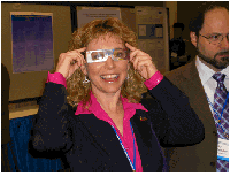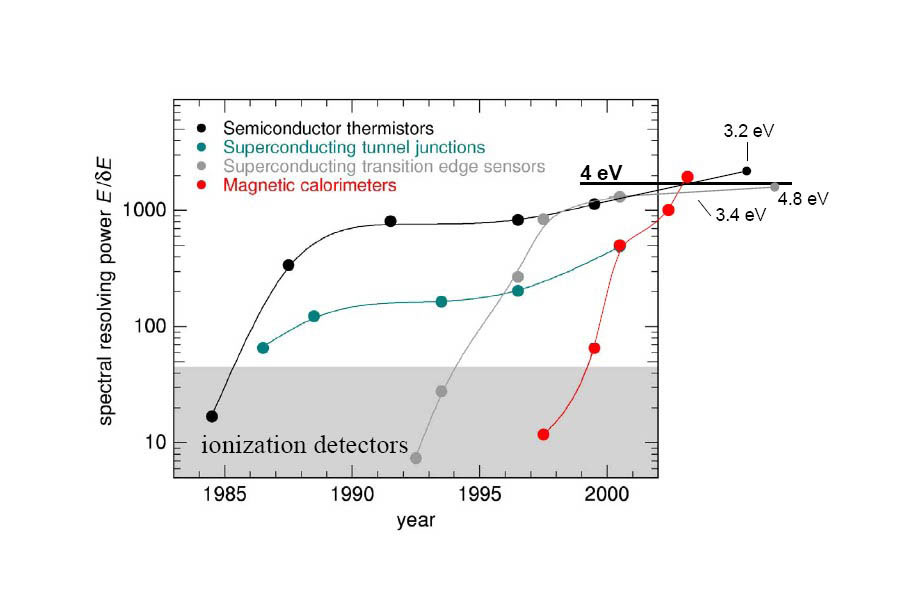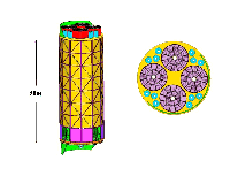Survey priorities were
re-affirmed by the 2005 NRC ‘Mid Course Review’.
Towards the end of 2005 Con-X and LISA took part in a
GSFC-led Technology Assesment, which studied the technical
readiness levels for key components to both missions. Con-X
technologies continue to make good progress towards a launch
in about 10 years, with the budget profile rather than
technologies constraining the launch date.
In our report here one year ago we noted that the best slumped glass mirrors that have made were close to meeting the mission requirements without the baseline gold layer epoxied onto the reflecting surface.

In our report here one year ago we noted that the best slumped glass mirrors that have made were close to meeting the mission requirements without the baseline gold layer epoxied onto the reflecting surface.

FIGURE 43: Dr. Kim Weaver of GSFC (former Con-X Deputy Project Scientist) tries on the new Constellation-X spectroscopy glasses. The glasses contain a pair of transmittion diffraction gratings. Con-X will contain a set of x-ray reflection gratings optimized for low-energy spectroscopy. Mission Scientist Jay Bookbinder of SAO is on the right.
A substantial effort this year has been devoted to understand the limitations of this thermal slumping process, in order to identify ways to improve it. Studies to date indicate that one of the limitations may be errors in the figure of the slumping mandrel. However, reduction of these errors may allow only a modest improvement in the figure of the slumped glass. Understanding and improving the physics of the slumping process may be more important to the figure of the mirror segments.

FIGURE 44: The energy resolution, expressed δE in eV, vs. time for a variety of classes of X-ray microcalorimeters. Several classes have already met the Con-X requirement of 4eV at 6keV. However, the δE is dependent on a large number of factors, and calorimeters with physical sizes and time constants appropriate for Con-X (ie, the transition edge sensors) have approached, but not yet met, the requirements. With the loss of the Suzaku calorimeter, the promise of non-dispersive high resolution X-ray spectroscopy will likely not be realized until Con-X.
Many separate groups have continued to make progress on the micro-calorimeter front. The best devices made to date have energy resolution better than the baseline mission requirements of 4eV at 6keV. However, these devices were not of the proper pixel size nor time resolution to be appropriate for use on Con-X. Devices with Con-X size and time parameters are approaching the required energy resolution, and improvements continue. Figure 44 shows a representative sample of micro-calorimeter energy resolution over time, showing the continuous improvements in energy resolution. The recent launch of Sukazu proved that micro-calorimeters can work in orbit, but also left the promise of the science they can yield unfullfilled.
Throughout 2005 a series of 15 workshops involving more than 60 scientists where held in order to examine the Con-X science case in light of the recent discoveries of Chandra and XMM. A brief summary of the conclusions is that the great imaging now being provided makes you thirst for high resolution spectroscopy even more! The workshops generated 15 white papers, containing over 100 pages of text, and were summarized in a May 2005 NASA technical publication titled ‘Science with Constellation-X’. The white papers and science booklet are available on the Con-X web site, http://constellation.gsfc.nasa.gov.
While the science staff was busy with workshops and white papers, the engineering staff was studying alternative Con-X configurations which could meet or exceed the mission requirements and reduce cost and/or complexity. The new availability of the Delta-IVH launcher, which has higher lift capacity than the baselined Atlas-V, was one of the principal motivations for this study. Initial studies indicate that a single Delta-IVH launcher would save ~$120m in launch costs and carry the baseline 4 spectroscopy plus 12 high energy telescope configuration into orbit on a single spacecraft. Other configurations, consisting of 3, 2, or even a single telescope were considered but appear less suitable than this configuration. If subsequent studies prove its viability, this 4+12 telescope in one spacecraft configuration may become the new baseline. Figure 45 shows a cartoon drawing of this possible new configuration.
A substantial effort this year has been devoted to understand the limitations of this thermal slumping process, in order to identify ways to improve it. Studies to date indicate that one of the limitations may be errors in the figure of the slumping mandrel. However, reduction of these errors may allow only a modest improvement in the figure of the slumped glass. Understanding and improving the physics of the slumping process may be more important to the figure of the mirror segments.

FIGURE 44: The energy resolution, expressed δE in eV, vs. time for a variety of classes of X-ray microcalorimeters. Several classes have already met the Con-X requirement of 4eV at 6keV. However, the δE is dependent on a large number of factors, and calorimeters with physical sizes and time constants appropriate for Con-X (ie, the transition edge sensors) have approached, but not yet met, the requirements. With the loss of the Suzaku calorimeter, the promise of non-dispersive high resolution X-ray spectroscopy will likely not be realized until Con-X.
Many separate groups have continued to make progress on the micro-calorimeter front. The best devices made to date have energy resolution better than the baseline mission requirements of 4eV at 6keV. However, these devices were not of the proper pixel size nor time resolution to be appropriate for use on Con-X. Devices with Con-X size and time parameters are approaching the required energy resolution, and improvements continue. Figure 44 shows a representative sample of micro-calorimeter energy resolution over time, showing the continuous improvements in energy resolution. The recent launch of Sukazu proved that micro-calorimeters can work in orbit, but also left the promise of the science they can yield unfullfilled.
Throughout 2005 a series of 15 workshops involving more than 60 scientists where held in order to examine the Con-X science case in light of the recent discoveries of Chandra and XMM. A brief summary of the conclusions is that the great imaging now being provided makes you thirst for high resolution spectroscopy even more! The workshops generated 15 white papers, containing over 100 pages of text, and were summarized in a May 2005 NASA technical publication titled ‘Science with Constellation-X’. The white papers and science booklet are available on the Con-X web site, http://constellation.gsfc.nasa.gov.
While the science staff was busy with workshops and white papers, the engineering staff was studying alternative Con-X configurations which could meet or exceed the mission requirements and reduce cost and/or complexity. The new availability of the Delta-IVH launcher, which has higher lift capacity than the baselined Atlas-V, was one of the principal motivations for this study. Initial studies indicate that a single Delta-IVH launcher would save ~$120m in launch costs and carry the baseline 4 spectroscopy plus 12 high energy telescope configuration into orbit on a single spacecraft. Other configurations, consisting of 3, 2, or even a single telescope were considered but appear less suitable than this configuration. If subsequent studies prove its viability, this 4+12 telescope in one spacecraft configuration may become the new baseline. Figure 45 shows a cartoon drawing of this possible new configuration.

FIGURE 45: Side and top views of an alternative Con-X configuration which contains the same total number of telescopes (and effective area) at the baseline mission, but packs them all into a single spacecraft which could be launched on a Delta IVH vehicle. This configuration would save approximately $120m in launch costs.
In closing, please join me in welcoming the new Con-X Instrument Scientists (IS) to the team: Jean Cottam is the Reflection Grating Spectrometer IS, Ann Parsons is the Hard X-ray Telescope IS, and Rick Shafer is the X-ray MicroCalorimeter Spectrometer IS.
Michael Garcia, for the Con-X team
45